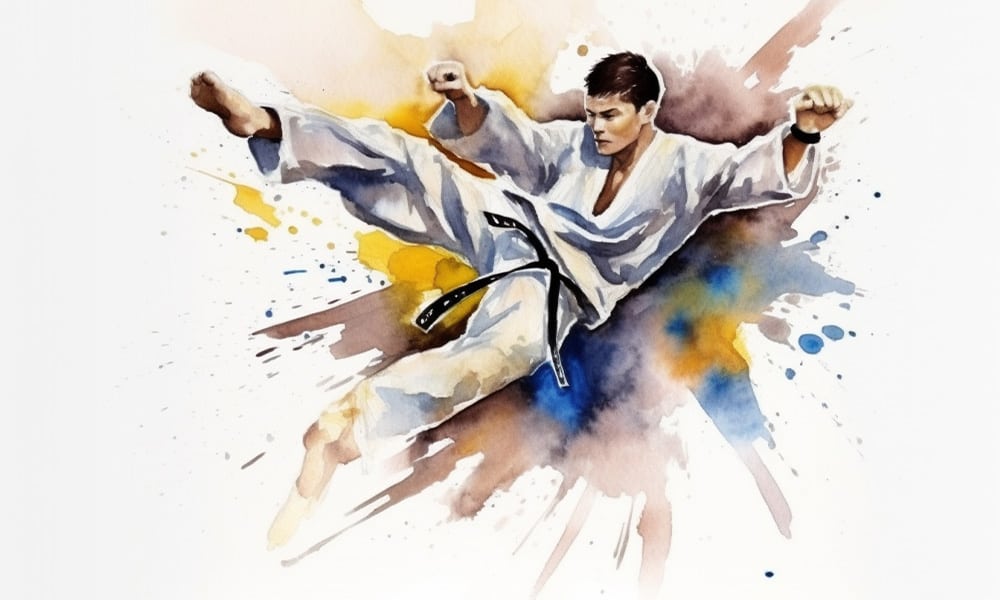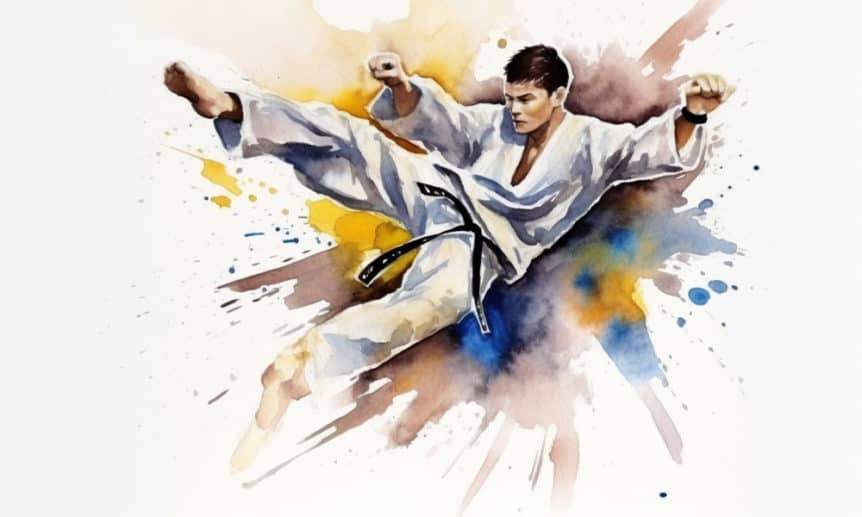
As a TaeKwonDo student, I’m captivated by the martial art’s fusion of physical skill, mental focus, and spiritual depth. Beyond its powerful kicks and disciplined forms, TaeKwonDo’s cultural richness shines through its stories and legends.
These tales, rooted in Korea’s history, have shaped TaeKwonDo into a global phenomenon, inspiring students and enthusiasts for generations. In this blog post, I explore three compelling stories—the Hwarang warriors, the flying kick, and the Tong-Il demonstration—that highlight TaeKwonDo’s enduring legacy, weaving together fact, folklore, and their impact on the martial art we practice today.
The Hwarang: Scholar-Warriors of Silla
In ancient Korea’s Silla Kingdom (57 BC–935 AD), the Hwarang, or “Flowering Knights,” were an elite group of young noblemen who embodied the ideals that continue to define TaeKwonDo. Formed in the 6th century by King Jinheung to bolster Silla’s military against rival kingdoms Goguryeo and Baekje, the Hwarang were more than fighters. Selected from aristocratic families, they trained in taekkyeon—a fluid, kick-based martial art and precursor to TaeKwonDo—as well as archery, horsemanship, and swordsmanship.
Under the guidance of Buddhist monk Won Gwang, they adhered to the Five Codes of Human Conduct: loyalty to the king, filial piety, trustworthiness among friends, courage in battle, and justice in action. These principles, blending Confucian and Buddhist values, shaped their character and resonate in TaeKwonDo’s tenets today.
The Hwarang’s training extended beyond combat. They studied poetry, music, dance, and philosophy, believing a true warrior should be culturally refined. Organized into units led by Hwarang commanders with Nangdo (Rangdo) cadets from non-aristocratic backgrounds, they traveled the peninsula, spreading taekkyeon and fostering cultural exchange. Their martial prowess and ethical code were pivotal in Silla’s unification of Korea by the 7th century, a legacy that endured through the Goryeo Dynasty (918–1392), where taekkyeon evolved into a systematic military practice.
One legendary tale features Samyeong, a Hwarang warrior said to have faced a tiger in the mountains with only his taekkyeon skills. Using quick reflexes and knowledge of the beast’s weaknesses, he subdued it, earning heroic status.
While such stories may be folklore, historical figures like Kwan Chang, who died bravely in battle against Baekje, underscore the Hwarang’s valor. Their influence persists in TaeKwonDo schools worldwide, where students learn not just techniques but the values of integrity, loyalty, and cultural appreciation, making the Hwarang a foundational pillar of the martial art’s philosophy.
The Flying Kick: A Leap Through Time
The flying kick, a hallmark of TaeKwonDo’s dynamic style, involves leaping into the air to deliver a powerful, often spinning kick. Its origins blend legend with the gradual evolution of Korean martial arts. One popular tale attributes the move to Yi Sun-sin, a 16th-century naval commander during the Japanese invasions of Korea (1592–1598).
Cornered on a narrow bridge, Yi Sun-sin reportedly leaped and kicked a Japanese soldier in the head, clearing a path for his troops. While this story captures the ingenuity of Korean warriors, no historical records confirm Yi Sun-sin’s martial arts prowess, suggesting it’s a cultural legend to highlight TaeKwonDo’s heritage.
More plausibly, the flying kick evolved from taekkyeon’s high, circular kicks, refined over centuries. During the Goryeo and Joseon Dynasties (1392–1910), martial arts texts like the Muye Dobo Tongji (1790) documented kicking techniques, indicating their military significance.
The modern flying kick took shape in the 20th century when TaeKwonDo was formalized by masters like General Choi Hong-hi and the nine kwans (schools). Post-1945, these kwans unified diverse styles, emphasizing dynamic kicks like the spinning and jumping varieties seen in competitions today.
Bruce Lee, a Jeet Kune Do innovator, also influenced the flying kick’s global prominence. His emphasis on speed and agility, inspired by various martial arts, popularized high kicks in films, though his direct link to TaeKwonDo’s development is less clear.
Today, the flying kick—whether a reverse turning kick or a 360-degree spin—requires rigorous training and embodies TaeKwonDo’s athletic artistry. It’s both a practical technique and a symbol of the martial art’s grace, captivating audiences in dojang demonstrations and Olympic sparring.
The Tong-Il Miracle: Unity in 1991
In 1991, the 10th World TaeKwonDo Championships in Athens, Greece, became a stage for a modern legend that transcends sport. Held from October 28 to November 3, the event saw 434 athletes from 49 countries compete, with South Korea topping the medal table. The men’s team sparring final pitted South Korea against North Korea in a tense, closely fought match.
South Korea emerged victorious, but the true legacy was what followed. In a planned act of reconciliation, the two teams performed a joint TaeKwonDo demonstration called Tong-Il, meaning “unity” in Korean, orchestrated by the World Taekwondo Federation (WTF, now World Taekwondo).
The Tong-Il showcase featured synchronized poomsae (forms) and breaking techniques, symbolizing shared Korean heritage amid Cold War-era divisions. This was especially poignant as both Koreas had joined the United Nations in September 1991, a rare moment of diplomatic alignment. The performance captivated global audiences, highlighting TaeKwonDo’s power to foster peace.
Its impact endures, inspiring later inter-Korean collaborations, such as joint demonstrations at the 2018 PyeongChang Winter Olympics, where WTF and ITF (International Taekwon-Do Federation) teams performed together. The Tong-Il remains a beacon of TaeKwonDo’s role in cultural diplomacy, urging practitioners to embrace unity in a divided world.
Key Stories and Their Impact on TaeKwonDo
To illustrate how these stories shape TaeKwonDo, here’s a table summarizing their origins, key figures, and contributions:
| Story | Origin | Key Figure/Event | Contribution to TaeKwonDo |
|---|---|---|---|
| Hwarang Warriors | 6th-century Silla Kingdom | King Jinheung, Won Gwang | Spread taekkyeon, instilled ethical codes |
| Flying Kick | Goryeo/Joseon to 20th century | Yi Sun-sin (legend), kwans | Emphasizes dynamic kicking, athletic artistry |
| Tong-Il Demonstration | 1991 World Championships | South/North Korean teams | Promotes unity, cultural diplomacy |
Final Thoughts
TaeKwonDo’s stories and legends are the heartbeat of its cultural and spiritual identity. The Hwarang’s blend of martial skill and ethical codes, the flying kick’s evolution from taekkyeon to modern spectacle, and the Tong-Il’s message of unity inspire practitioners and newcomers alike.
These narratives remind us that TaeKwonDo is more than a martial art—it’s a living tradition rooted in Korea’s history and vibrant with global impact. Whether you’re refining your kicks or exploring TaeKwonDo’s heritage, these stories invite you to connect with a legacy that continues to shape the world.

